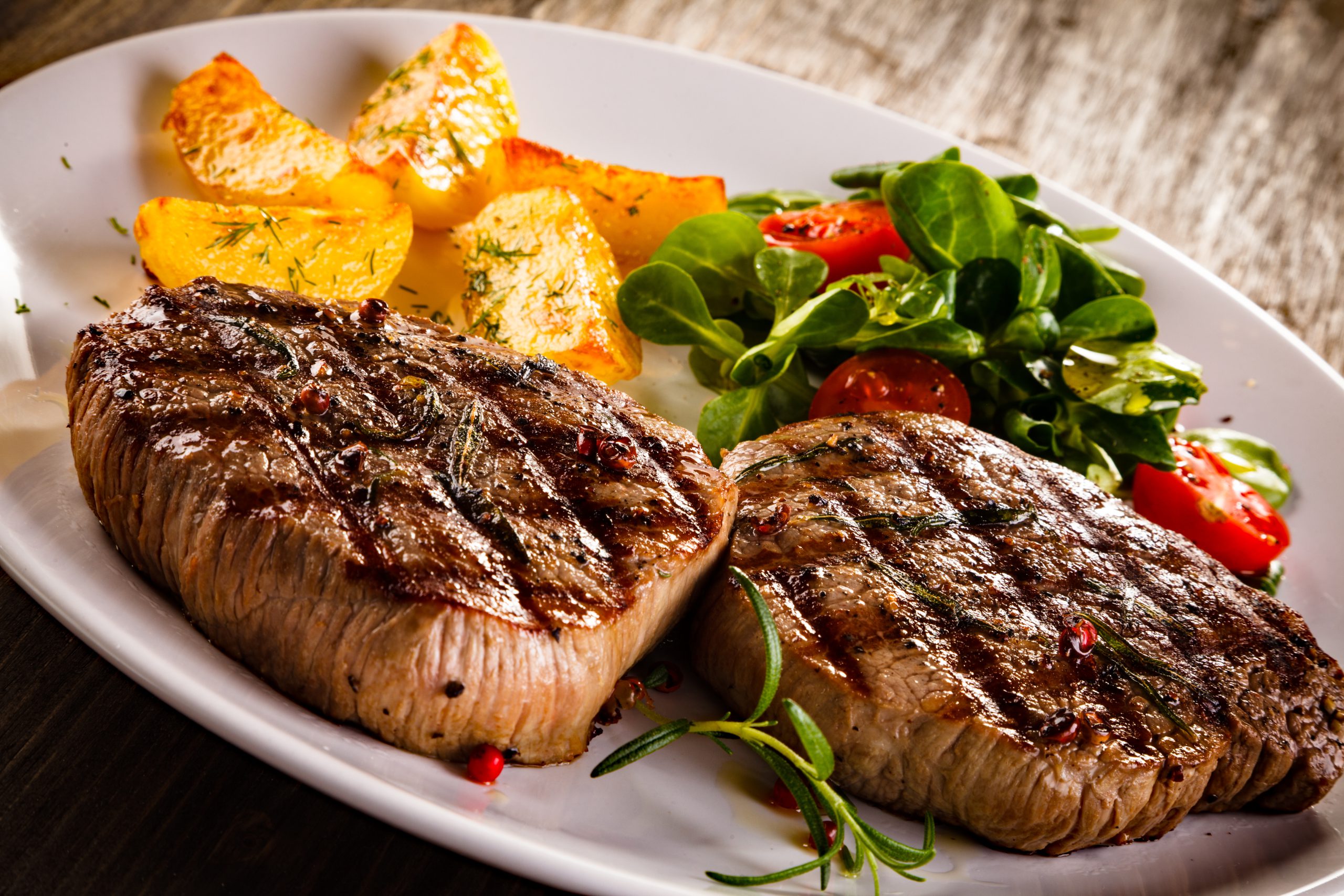
How to Grill the Best Steak
The most foolproof way to grill the best steak? It’s not complicated—it’s about small details, like a picking the best cut, air-drying in the fridge, and making an herb butter sauce for basting. Fire up the grill!
My goal with this recipe was to create a grilled steak that would make a novice look like a master, and a master look like her backyard flame-created opus was mere child’s play.
Grilling the Best Steak
I wanted a juicy steak with a nice crust that was big enough to slice and serve family style, and that had a little finessWhile cooking, I basted the steak in an herbed butter sauce. The sauce added a fresh, light flavor that balanced the richness of the meat. In the end, I had a steak everyone raved about, and that felt special but not overly fussy. It was the perfect main course for my Fourth of July party plans.
Which Cut of Steak Is Best for Grilling?
When I first started working on this recipe, my top contenders for the steak were the ribeye (no bone), the rib steak (same cut as the ribeye but with the bone), the porterhouse, and the T-bone.
Ultimately, I chose to use ribeye steak for its flavor, size, and the lack of bone — I wanted to slice and serve this steak family-style, and the fact that it doesn’t have a bone makes that easier.
The ribeyes I used to test this recipe were 1 1/2 inches thick and weighed in at a whopping 1 1/4 pounds each. Because this cut has extensive fat marbling, it stays tender and tastes great after grilling. A steak this size is also ideal for serving two people, which means less meat to manage on the grill at one time.
I chose to use a thick cut because of its forgiving nature for a newbie at the grill—it’s pretty easy to overcook a 1-inch steak, but adding just a half inch can give you some extra leeway when you’re first mastering the technique.
This being said, a big bone-in steak is an impressive sight and beautiful on a plate. Bone in or bone removed, it’s up to you!
Amp Up the Flavor With Butter Sauce
When I first began work on this recipe, I tried dry rubs, oil, and simple salt and pepper. All of these are wonderful things to put on steaks, but I felt like it needed more. (I had Fourth of July in mind, and I wanted to make it special but not complicated.)
I settled on basting the steak with an herbed butter sauce. First, because butter. Second, because I have an extensive herb garden and it didn’t require a trip to the store. I was worried that the butter might burn on the grill, and leave an acrid flavor, but it didn’t.
It was pure deliciousness. The herbs added complexity without masking the meatiness of the steak.
Advice From Grilling Expert Steven Raichlen
Deciding the flavor and the cut I wanted was the easy part. I turned to grilling expert Steven Raichlen, founder of BBQ University, television host, and the author of more than 30 books on the topic of grilling, on how best to set up my grill.
He generously took my phone call while on tour promoting his most recent book release, Project Fire.
Charcoal or Gas Grill for Steak?
Charcoal or wood-fired grills are always the best choice for grilling steaks because of the additional flavor and charring they provide. If you have a charcoal grill, you also can add different kinds of wood to the fire to contribute smokiness and enhance the overall flavor of the meat.
Don’t worry—you can still cook a great steak on a gas grill. If using gas, open the lid, turn on the gas, and light the grill. Don’t light the grill with the lid closed; gas can build up inside the grill and create an explosion.
How Hot Should the Grill Be for Steak?
Raichlen recommends establishing two cooking zones in your charcoal grill: one that’s very hot for searing the steak, and one that’s medium for finishing the steak and cooking it through.
On a gas grill, heat the grill to 450°F with two burners going, which should only take about 10 minutes, then turn one of the burners down to medium to create two cooking zones.
Not sure if the grill is hot enough? Raichlen’s tip is to hold your hand 3 inches above the grill grate and count “1 Mississippi, 2 Mississippi…” If you can only hold it there for a second or two, the grill is hot and you’re ready to cook.
I followed Raichlen’s advice, and started my steak in the hot zone, then moved it to the medium zone to finish cooking. It worked like a charm.
How Long to Grill Steak
For a 1 1/2-inch thick steak, here are the general cooking times:
- 6 to 8 minutes for rare (125°)
- 7 to 10 minutes for medium-rare (135°)
- 10 to 12 minutes for medium (145°)
- 12 to 15 minutes for well done
Note that the USDA recommends cooking whole cuts of beef to an internal temperature of 145°F.
Keep in mind that the thickness of your steak, the heat of your grill, and your desired level of doneness will all impact the time it takes your steak to grill.
Tips for Grilling the Perfect Steak
- Season, then chill: I apply the same technique I use for getting crispy chicken and turkey skin to grilling this steak: season, then let it chill in the fridge uncovered for up to 48 hours. This essentially dry brines the steak while also letting it air-dry. This approach allows the surface moisture to evaporate while the seasoning has time to penetrate the meat resulting in deeply flavored steak that sears beautifully and develops a nice crust on the grill.
- Start with clean grates: Just like you use a clean skillet with a little oil to cook dinner on the stovetop, you want to start with clean and oiled grill grates.
- To flip or not to flip? Flip your steak to your heart’s content. Harold McGee, food science writer and author of On Food and Cooking, discovered that frequent flipping creates a steak that cooks more evenly and quickly than those flipped only once.
- Grilling directly on coals: Raichlen seemingly knows an infinite number of ways to grill meat, and there’s one in his new book, Project Fire , that I particularly like: he cooks steak directly on hot coals—no grill grates necessary. I love the idea, and it’s on my list of things to try in the near future.

Ingredients
For the steak:
-
1 1/2-inch thick ribeye, bone in or out (about 1 1/2 pounds without the bone)
-
3/4 teaspoon coarse sea salt or kosher salt
-
1 teaspoon freshly ground pepper
For the herb butter sauce:
-
4 tablespoons butter
-
Leaves from 4 sprigs of thyme
-
1 tablespoon minced fresh rosemary
-
1 clove garlic, minced
-
1 shallot, about half the size of a golf ball, minced
Method
Trim the fat:
-
Remove the outer layer of fat from the ribeye. The interior marbling will flavor the meat, whereas the outer fat layer will produce flare ups on the grill, which can add a burnt (not charred) flavor to the steak.
:max_bytes(150000):strip_icc():format(webp)/__opt__aboutcom__coeus__resources__content_migration__simply_recipes__uploads__2018__06__Grilled-Steak-METHOD-2-fd81693f33c2416891c62c49dda9c77a.jpg) Season the steak and refrigerate:
Season the steak and refrigerate: -
Pat the steak dry with a paper towel. This removes surface moisture and will help you achieve a good sear.
Season each side with salt and pepper and rub them in a bit. Put the steak in the fridge, uncovered, for at least an hour and up to 48 hours.
-
Make the herbed butter:
In a small saucepan, add butter, herbs, garlic, and shallots. Melt over low heat. Do this at least 10 minutes before you are ready to put the steak on the grill. The longer the herbs sit in the butter, the longer the flavors will infuse.
You can also make this butter up to 2 hours beforehand; if so, cover and refrigerate. Gently reheat the butter to melt it again before you put the steaks on the grill.
:max_bytes(150000):strip_icc():format(webp)/__opt__aboutcom__coeus__resources__content_migration__simply_recipes__uploads__2018__06__Grilled-Steak-METHOD-3-f69ad7bd9fbe4dfb89d4332b39f7dc81.jpg)
-
Preheat the grill:
Prepare a charcoal grill for two-zone grilling, so half is hot and one half is warm. The grill is hot when you can only hold your hand over the hot zone for a second or two.
On a gas grill, heat the grill to 450°F with two burners going, which should only take about 10 minutes, then turn one of the burners down to medium to create two cooking zones.
:max_bytes(150000):strip_icc():format(webp)/__opt__aboutcom__coeus__resources__content_migration__simply_recipes__uploads__2018__06__Grilled-Steak-METHOD-1-ab838e34d4764a99bd016975e4fc5da3.jpg)
-
Cook and baste the steak:
Add the steak to the hottest side of the grill. Close the lid and sear for 2 minutes. Open the lid, flip the steak, and baste it with the melted herb butter and herbs. Close the lid. Cook for 2 additional minutes.
Flip the steak again and move it to a lower heat side. Baste it again with butter. Continue flipping and basting every two minutes for the next 6 minutes, closing the lid between each flip.
After the steak has been on the grill for a total of 10 minutes (for medium-rare steak), transfer it to a clean platter; it should read 137°F to 140°F internally. Baste it again with butter. (Continue cooking for longer if you prefer your steak more well-done.)
:max_bytes(150000):strip_icc():format(webp)/__opt__aboutcom__coeus__resources__content_migration__simply_recipes__uploads__2018__06__Grilled-Steak-METHOD-4-0e1dd84f5e554d4ebb6b110d698ca32e.jpg)
:max_bytes(150000):strip_icc():format(webp)/__opt__aboutcom__coeus__resources__content_migration__simply_recipes__uploads__2018__06__Grilled-Steak-METHOD-5-5c978585dda04c4f9d83743fd7a1e1c8.jpg)
:max_bytes(150000):strip_icc():format(webp)/__opt__aboutcom__coeus__resources__content_migration__simply_recipes__uploads__2018__06__Grilled-Steak-METHOD-6-18b24e4448744b40a9c69e9dde1d4ebb.jpg)
-
Let the steak rest:
Let it rest for 5 minutes; it will climb another few degrees as it sits and the juices will redistribute.
-
Slice and serve the steak:
Slice the steak against the grain. Pour any remaining herb butter sauce over top and serve.
:max_bytes(150000):strip_icc():format(webp)/__opt__aboutcom__coeus__resources__content_migration__simply_recipes__uploads__2018__06__Grilled-Steak-LEAD-3-271c439dd7474d298e88eb76f34801b8.jpg)
| NUTRITION FACTS(PER SERVING) | |
|---|---|
| 1163 | CALORIES |
| 88g | FAT |
| 9g | CARBS |
| 86g | PROTEIN |



0 Comments